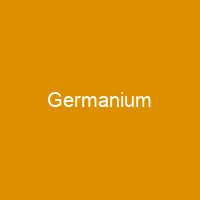Germanium: The Unassuming Element with a Big Impact
Imagine an element so unassuming that it was only discovered late in the 19th century despite being abundant in our planet’s crust. That’s Germanium, symbol Ge and atomic number 32. This metalloid, lustrous yet hard-brittle, has a history as intriguing as its properties. How much do you know about this element that plays such a crucial role in modern technology?
The Discovery of Germanium
Was it destiny or mere coincidence that Dmitri Mendeleev predicted the existence of germanium before its actual discovery? Mendeleev, with his keen eye for periodicity, placed this element between silicon and tin on the periodic table. It was only in 1886 when Clemens Winkler isolated it from argyrodite, a mineral discovered near Freiberg, Saxony, that germanium became an official member of the chemical family.
Germanium: The Semiconductor Star
When we talk about semiconductors, Germanium is often in the spotlight. From its initial discovery as a poorly conducting metal to becoming a key player in electronic devices post-World War II, germanium’s journey is nothing short of fascinating. Its role in transistors and diodes during the war laid the groundwork for modern electronics.
The Demand Surge
How did germanium go from being a niche element to a critical material? The answer lies in its applications, particularly in fiber optics, infrared technology, and polymerization catalysts. By 2000, these end uses represented an astounding 85% of global consumption. The US even deemed it strategic, with plans for a national defense stockpile.
Production and Availability
Germanium’s production is primarily from sphalerite zinc ores and coal deposits. Despite its importance, the supply chain remains complex due to limited exploitable sources compared to silicon, which can be extracted from sand and quartz. The price disparity between germanium ($800 per kg) and silicon ($10 per kg) highlights this element’s value.
The Physical Properties
Germanium is a brittle, silvery-white semiconductor with unique physical properties. Its threshold displacement energy of 19.7 – 0.5 + 0.6 eV and its ability to form various compounds make it a versatile material in electronics and optics.
The Future of Germanium
With the rise of spintronics and quantum computing, could germanium be on the cusp of another technological revolution? Its role in advanced electronics and its strategic importance to countries like China underscore its significance. As we move towards a green and digital future, the demand for germanium is only set to grow.
The Challenges
While germanium’s applications are vast, it also poses challenges. Its reactive compounds can be toxic, with some forms causing renal dysfunction and peripheral neuropathy in long-term users. Proper handling and regulation are crucial for its safe use.

In conclusion, germanium is more than just a chemical element. It’s a testament to the unpredictability of scientific discovery and the far-reaching impact of technology. As we continue to explore its properties and applications, one thing remains clear: Germanium is not just an element; it’s a key player in shaping our technological future.
You want to know more about Germanium?
This page is based on the article Germanium published in Wikipedia (retrieved on December 3, 2024) and was automatically summarized using artificial intelligence.







